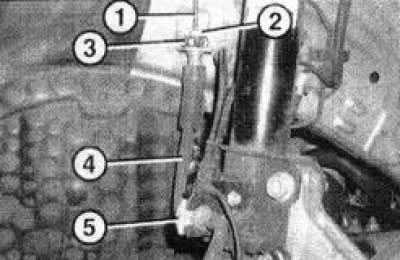2. Each time during maintenance, check all elements of the brake system for cracks, signs of damage to the containment, signs of fluid leaks, swelling and other damage. The hoses are the critical and most vulnerable part of the brake system, so they must be inspected with the utmost care. If any doubtful signs are found, the suspected hose must be replaced.
Attention: Do not allow brake hoses to come into contact with oil and gasoline, do not expose them to painting, as well as to special compounds for anti-corrosion protection of the bottom.
3. Over time, during the operation of the car, old brake hoses can swell, while their flow area decreases - this makes it difficult for the brake fluid to return to the GTZ and the brake pads to be completely removed from the disc. As a result, the brake mechanisms heat up, which can lead to failure of both the mechanisms themselves and the wheel bearings.
4. Replacement steel and flexible brake lines can always be purchased at branded service stations, as well as in branded auto accessories stores.
Attention: In no case should you use any tubes as replacements, except for branded ones, specially designed for installation in the brake circuit of your car.
5. If it is necessary to replace the metal brake lines, you must contact the Opel service station, because. their laying requires a certain skill and qualification, careless handling can lead to bending of the tubes and affect the size of the flow area of the channel. Brake lines must be at least 20 mm away from moving or vibrating body, suspension or steering components. During installation, all standard clamps and line holders must be used.
6. Before replacing the hose, check the brake fluid level in the reservoir and top up if necessary. Remove the corresponding wheel. Have plugs ready to plug the brake lines after disconnecting them, and a rag to clean up spilled brake fluid.

4.6 Fastening the brake hose (4) rear wheel: 1. Union nut; 2. Locking bracket; 3. Metal brake line; 5. Hollow bolt
Note: The procedure for replacing the front wheel brake hose is described below. Replacing the rear wheel brake hose is done in almost the same way, with the only difference that the intermediate hose holder is not provided (see resist. illustration).
7. To loosen the flexible hose fittings with the steel tubing of the hydraulic lines, use a special box wrench with a split head. After releasing the union nut, remove the retaining clip and release the brake hose from the support bracket (see resist. illustration) in the wheel arch, - the retaining clip must be reinstalled after the hose has been disconnected. Immediately close the brake pipe with the prepared plug.

4.7 Loosening the union nut (2) choke connection with a metal line (1), remove the retaining clip (3) and release the brake hose (4) from bracket: 5. Stop plate
8. Remove the hollow bolt (see resist. illustration) and disconnect the brake hose from the caliper union. Remove the old sealing washers - during assembly, the washers must be replaced without fail.

4.8 Attaching the brake hose (4): 5. Locking plate; 6. Hollow bolt
9. Release the hose from the intermediate holder on the shock absorber (see illustration 4.8), for which, using pliers, remove the locking plate.
10. Make sure that the new brake hoses exactly match the dimensions and specifications removed from the car.
11. Fix a brake hose with new sealing rings on a support, tighten a hollow bolt with the demanded effort. Then remove the plug and connect the hose to the metal brake line, tighten the union nut. After that, fix the hose in the intermediate holder on the shock absorber - make sure that the hose is not twisted during installation.
12. With the front wheels suspended, turn the steering wheel to the right and left - the hose should not interfere with the moving parts of the steering mechanism and come into contact with other structural elements.
13. After replacing the hose, be sure to remove air from the brake system using a special device. Check the fluid level in the GTZ reservoir, correct if necessary.
14. Before starting the operation of the car, make sure that the brakes are working properly.

Visitor comments